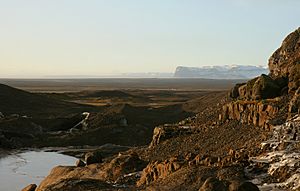Outwash plain facts for kids
An outwash plain is a wide, flat area of land formed by melting glaciers. Imagine a giant river of ice, called a glacier. As this ice moves, it grinds up rocks and picks up lots of dirt and sand. When the glacier starts to melt, all that material is washed out by the water. This water spreads out, dropping the rocks and dirt, creating a very smooth and flat plain.
Contents
How Outwash Plains Form
Outwash plains are also known as sandurs. They are created when glaciers melt. Glaciers are huge sheets of ice that slowly move across the land. As they move, they act like giant bulldozers. They scrape and pick up all sorts of material. This includes rocks, gravel, sand, and fine dirt called silt.
The Role of Meltwater
When a glacier reaches warmer areas, it starts to melt. The melting ice creates a lot of water. This water flows away from the glacier, often in many small streams. These streams carry all the rocks and dirt that the glacier picked up.
The heavier, larger rocks are dropped first, closer to the glacier. The lighter materials, like sand and silt, are carried much further by the water. As the water spreads out, it slows down. This causes the sand and silt to settle, forming a wide, flat plain. Because the water spreads the material so evenly, outwash plains are usually very smooth and flat.
Where Can We Find Outwash Plains?
Outwash plains are found in areas where glaciers have been or still are. They are common in places that were once covered by large ice sheets during past ice ages. You can also find them near active glaciers today.
Examples Around the World
One of the most famous outwash plains is called Skeiðarársandur. It is located in Iceland. This plain is very large and flat. It was formed by the melting water from the Skeiðarárjökull glacier.
Other places with outwash plains include:
- Alaska in the United States
- Parts of Canada
- Some areas in New Zealand
- Regions in Patagonia, South America
These plains are important because they show us how glaciers change the Earth's surface. They are also often used for farming because their soil can be quite fertile.
Images for kids
-
Unimpeded by topographic obstructions, sand-bearing katabatic winds can be fierce enough on Skeiðarársandur to strip paint from cars. Here, sand is blown in the air in front of the peak Lómagnúpur.
See also
 In Spanish: Sandur para niños
In Spanish: Sandur para niños



